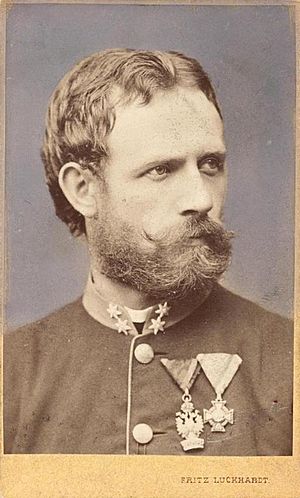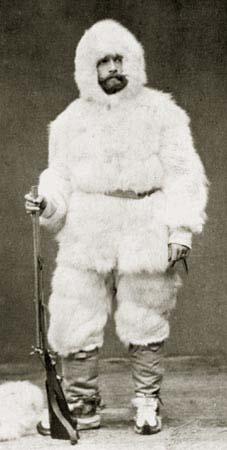Julius von Payer facts for kids
Quick facts for kids
Julius von Payer
|
|
|---|---|

Julius Payer as First Lieutenant (around 1865)
|
|
| Born | 2 September 1841 |
| Died | 29 August 1915 (aged 73) Veldes (Bled), Carniola
Austria-Hungary |
| Resting place | Vienna Central Cemetery |
| Nationality | Austrian |
| Known for | Austro-Hungarian North Pole expedition |
Julius von Payer (born September 2, 1841 – died August 29, 1915) was an amazing adventurer. He was an officer in the Austro-Hungarian Army, a skilled mountain climber, and a brave explorer of the Arctic. He also drew maps and was a talented painter.
Julius von Payer is best known for leading an expedition to the North Pole region between 1872 and 1874. During this trip, he discovered a group of islands called Franz Josef Land. In 1876, he was given the special title "Ritter von Payer."
Contents
Early Life and Army Days
Julius was born in a place called Schönau, in Bohemia. His father, Franz Anton Rudolf Payer, was a retired army officer. Sadly, Julius's father passed away when Julius was just fourteen years old.
Julius went to a special cadet school near Kraków, which is now in Poland. Later, from 1857 to 1859, he studied at the Theresian Military Academy in Wiener Neustadt.
Joining the Army
In 1859, Payer became a sub-lieutenant in the Austrian army. He served with the 36th infantry regiment in Verona. He even took part in a big battle called the Battle of Solferino in 1859. He was honored for his bravery there.
Later, in 1864, he was promoted to lieutenant first class. He was then sent to a town called Chioggia. In 1866, he fought in another battle, the Battle of Custoza. He captured two cannons, which was a very brave act. Because of this, he was given another award and became a senior lieutenant.
Teacher and Mapmaker
From 1863, Julius Payer also worked as a teacher. He taught history and geography at the cadet school in Eisenstadt. He also taught at the Theresian Military Academy.
In 1868, the Minister of War, Franz Kuhn von Kuhnenfeld, gave him a new job. Payer became a general staff officer at the Military Geographic Institute in Vienna. Here, he worked on making maps.
Exploring the Alps
Even while in the army, Payer loved exploring mountains. In 1862, he started taking trips to the Tyrolean Alps and the High Tauern mountain range.
After 1864, he explored the Adamello-Presanella Group and the Ortler Alps. He was the first person to climb over 60 different peaks!
First Ascents
In 1864, Payer and his guide, Giovanni Caturani, were the first to climb Adamello, a mountain 3,554 meters high. He almost made the first climb of Presanella (3,558 meters) too, missing it by only three weeks.
From 1865 to 1868, Payer explored the Ortler mountains. He always had a guide named Johann Pinggera with him. They often brought a porter to help carry their gear. Together, they climbed almost all the important peaks that no one had climbed before. These included Hoher Angelus, Vertainspitze, Palon de la Mare, Monte Zebru, and Monte Cevedale.
Their new way of climbing the Ortler mountain (3,905 meters) became the most common route for climbers ever since.
Mapping the Mountains
All of Payer's mountain trips helped him create a very detailed map of the area. This map was drawn at a scale of 1:56,000. Because of his amazing work, Payer was moved to the Austrian Military Geographic Institute.
In 1875, the first mountain hut above 3,000 meters was built on the Ortler climbing route. It was named de:Payerhütte in his honor.
Arctic Adventures
In 1868, a German geographer named August Petermann invited Payer to join an expedition. This was the 2nd German North Polar Expedition. Payer went as a topographer, meaning he would draw maps of the land. They traveled to the coast of East Greenland on a ship called the Germania. This trip happened between 1869 and 1870. They went as far north as Shannon Island.
In 1871, Payer joined another expedition. This was a preliminary trip for the Austro-Hungarian Empire to Novaya Zemlya. He went with Karl Weyprecht on this journey.
Discovering Franz Josef Land
From 1872 to 1874, Julius Payer led the famous Austro-Hungarian North Pole expedition. Karl Weyprecht was the commander at sea, while Payer was the commander on land.
During this incredible journey, they discovered a new group of islands. They named these islands Franz Josef Land. When they returned to Vienna, some people doubted their discovery. They questioned if Franz Josef Land really existed. Payer had diaries, sketches, and other proof, but it was still a challenge to convince everyone.
Because of these challenges, Payer decided to leave the army in 1874. Even so, he was awarded a small amount of money for discovering Franz Josef Land. In 1875, he also received the Royal Geographical Society's special Patron's Medal.
On October 24, 1876, Julius Payer was given a very special honor. He was elevated to the Austrian nobility. This meant he and his future male descendants could use the title Ritter von. Female descendants could use von.
Later Life and Art
In 1877, Julius von Payer got married. He later had two children, a son named Jules and a daughter named Alice.
From 1877 to 1879, he studied painting in Frankfurt am Main. He continued his art studies in Munich from 1880 to 1882.
Payer then worked as a painter in Paris from 1884 to 1890. After that, he returned to Vienna and even started a painting school for ladies.
He continued to dream of new adventures. In 1895, he planned a trip to Greenland to paint the beautiful landscapes. In 1912, when he was 70 years old, he even planned an expedition to the North Pole using a submarine!
Julius von Payer passed away in 1915 in a place called Veldes, which is now part of Slovenia.
Places Named After Julius von Payer
Many places have been named after Julius von Payer to remember his amazing achievements:
- The Payerhütte, a mountain hut in the Alps.
- Several streets in Vienna.
- Payer Island, an island in Franz Josef Land.
- The Payer Mountains in Antarctica.
- Payer Land in eastern Greenland.
Even a special camp for a Mars mission simulation was named Station Payer in 2013. This camp was near a main base called Camp Weyprecht, named after his fellow explorer.
See also
 In Spanish: Julius von Payer para niños
In Spanish: Julius von Payer para niños
- The Austro-Hungarian polar expedition led by Julius von Payer was featured on a special Austrian coin in 2005. The coin shows two explorers in Arctic gear with their frozen ship, the "Admiral Tegetthoff," behind them.
- Payer Island



